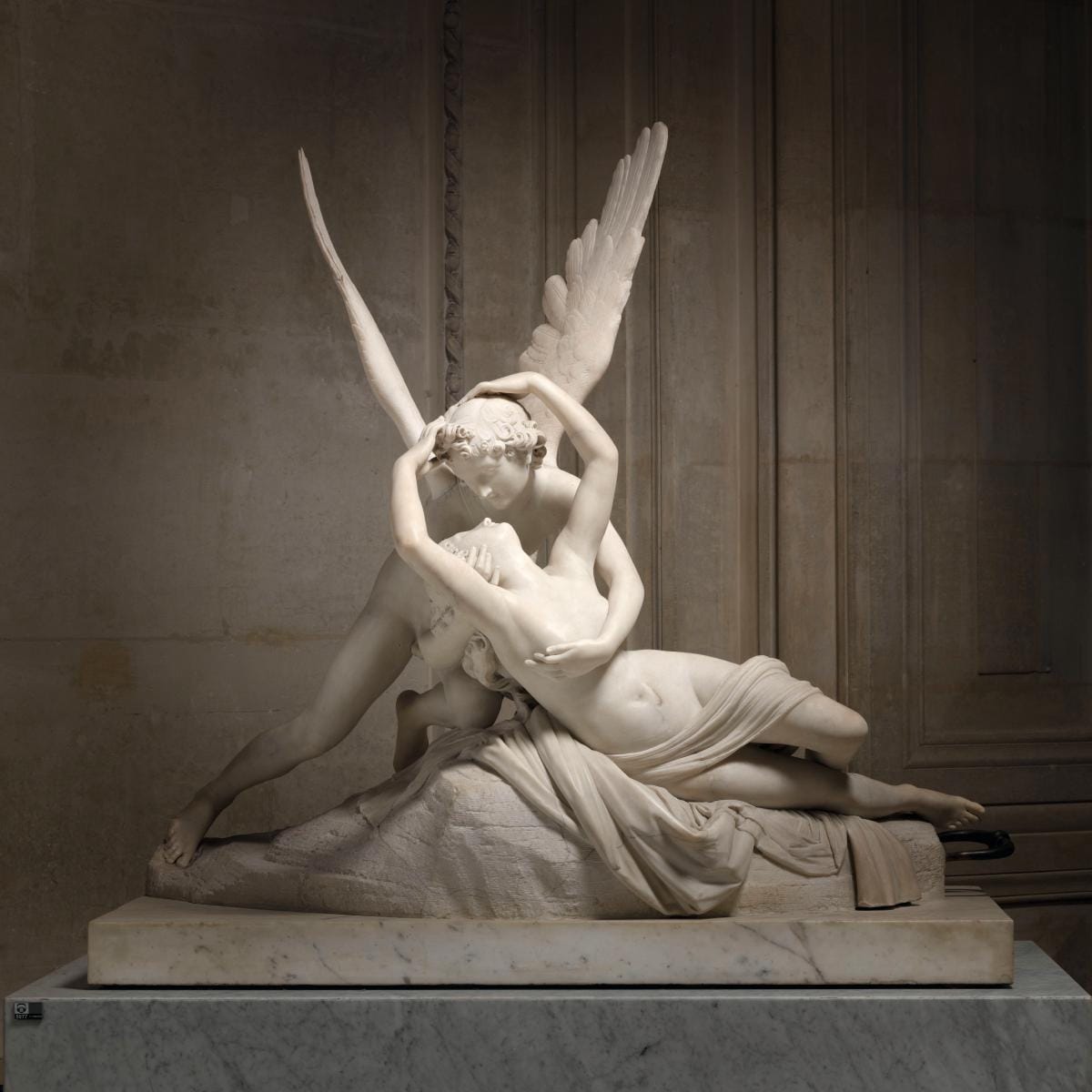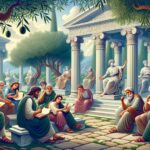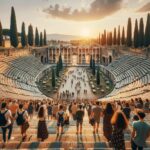“The soul, like a butterfly, emerges from its chrysalis transformed.” While not directly attributed to Antonio Canova, this sentiment eloquently captures the essence of his breathtaking sculpture, Psyche Revived by Cupid’s Kiss. This 1793 masterpiece transcends mere marble, narrating a timeless tale of love, transformation, and the enduring allure of Neoclassicism. This article offers a comprehensive analysis of Canova’s iconic work, exploring its mythological origins, artistic techniques, and lasting influence on Western art. Discover the timeless beauty of Antonio Canova’s renowned masterpiece, the cupid and psyche sculpture, a poignant embodiment of love, romance, and transformation.
The Mythic Resonance
The myth of Cupid and Psyche, originating from Apuleius’s The Golden Ass, provides the narrative foundation for Canova’s sculpture. Psyche, a mortal woman whose beauty rivaled that of Venus, goddess of love, incurred the goddess’s wrath. Venus, consumed by jealousy, commanded her son Cupid to make Psyche fall in love with a monstrous being. However, Cupid, captivated by Psyche’s beauty, accidentally wounded himself with his own arrow and fell deeply in love with her. He visited her only in darkness, forbidding her from ever gazing upon his face. Influenced by her envious sisters, Psyche broke this promise, illuminating Cupid’s divine form with a lamp. A drop of hot oil awakened the god, who, feeling betrayed, departed. Psyche, devastated, embarked on a series of arduous tasks imposed by Venus to atone for her transgression and reclaim Cupid’s love. Her unwavering devotion ultimately moved the gods, culminating in Psyche’s ascension to immortality and her reunion with Cupid. Venus even warns Psyche not to open a jar, testing her obedience (Canova masterfully avoids direct depiction of this, focusing on the reunion).
Canova’s sculpture captures the emotional core of this myth—the power of love, the pain of loss, and the promise of redemption. While other artistic representations, such as Pompeian frescoes and Renaissance paintings, depict various episodes from the myth, Canova focuses on the pivotal moment of reunion, imbuing it with a palpable sense of tenderness and forgiveness. The sculpture functions as a visual embodiment of the soul’s journey toward enlightenment and the transformative power of love.
Neoclassicism Embodied
Neoclassicism, flourishing in the 18th century, found inspiration in the idealized forms and noble themes of ancient Greek and Roman art. Characterized by balanced compositions, restrained emotions, and mythological subject matter, Neoclassicism sought to revive the classical spirit in a modern context. Canova’s Psyche Revived by Cupid’s Kiss epitomizes these principles. The figures’ idealized forms, reminiscent of classical statuary, convey a sense of timeless beauty. The restrained yet palpable emotion, evident in their gentle embrace, reflects the Neoclassical emphasis on balance and harmony. However, the sculpture also hints at the nascent Romantic movement with its subtle emotional intensity, suggesting Canova’s position at the cusp of two artistic eras. The 18th-century art world was a dynamic environment, with the rediscovery of Herculaneum and Pompeii fueling a renewed interest in classical antiquity, directly influencing Canova’s artistic development. His grandfather, a stonemason, and his Venetian training further shaped his approach, evident in his masterful handling of marble.
A Sculptural Narrative
The sculpture’s composition, a graceful interplay of lines and forms, draws the viewer into the intimate moment of reunion. Cupid, wings delicately unfurled, leans towards Psyche, his tender kiss awakening her from a death-like slumber. Psyche, reaching upwards, embodies a nascent awakening, her expression a blend of surprise and burgeoning love. The dynamic interplay of their bodies creates a sense of movement and anticipation. The contrasting textures—the smooth, almost luminous skin of the figures juxtaposed with the roughly hewn rock base—amplify the sculpture’s realism and emotional impact. The rock, perhaps, symbolizes the trials and tribulations Psyche overcame. Canova’s technical virtuosity is evident in the meticulous detailing of Psyche’s flowing hair, Cupid’s meticulously rendered wings and the intricate folds of the drapery cascading over Psyche’s form. These details, rendered with exceptional precision, elevate the sculpture beyond mere representation, transforming it into a poignant narrative.
Unveiling the Symbolism
Rich in symbolism, Psyche Revived by Cupid’s Kiss invites multiple interpretations. Psyche’s nascent butterfly wings, often interpreted as representing her soul, suggest the transformative power of love and the promise of rebirth. The kiss itself, a symbol of reconciliation and renewed life, embodies the enduring strength of the human spirit. The sculpture’s rotating base, a unique feature likely added later, enhances the viewer’s engagement with the work, allowing for a 360-degree perspective and a deeper appreciation of its three-dimensionality. This innovation underscores Canova’s desire to create a truly immersive experience, enabling viewers to connect with the emotional core of the narrative.
An Enduring Legacy
Psyche Revived by Cupid’s Kiss, commissioned in 1787 by Colonel John Campbell, solidified Canova’s reputation as a leading figure of Neoclassicism. The existence of multiple versions, including one acquired by Prince Yusupov in 1796 and another by Joachim Murat in 1800 before the primary version entered the Louvre in 1824, attests to the sculpture’s widespread acclaim. The work’s enduring legacy stems from its timeless themes of love, loss, and redemption, which continue to resonate with contemporary audiences. It stands as a testament to the power of art to transcend time and culture, inviting continued contemplation of the human condition. What new interpretations might future generations glean from this masterpiece? Perhaps the answer lies not only within the sculpted marble but also within the evolving narrative of human connection and the search for meaning.
The original commission by Colonel John Campbell opens a fascinating window into the art patronage of the era. Further research into Campbell’s motivations could provide valuable insight into the social and cultural context of the sculpture’s creation. Additionally, comparing the subtle differences between the existing versions—dimensions, poses, and degree of finish—could offer a unique perspective on Canova’s artistic process and the evolution of his vision. While some experts believe the rotating base was an integral part of Canova’s design, others suggest it was a later addition, a debate that continues to intrigue scholars. Ongoing research into Canova’s innovative techniques and his daring blend of Neoclassical and Romantic elements further enriches our understanding of this iconic masterpiece.
- Georgia Platform: A Southern Strategy, 1850s - March 31, 2025
- How many weeks is 40 days: Quick Conversion Guide for Accurate Results - March 31, 2025
- How many feet is 300 meters? 984 Feet: Understand Length Conversions Easily - March 31, 2025
















